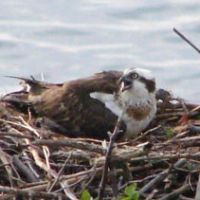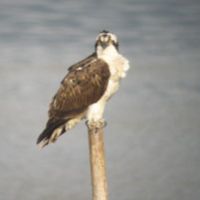There is a moment of commitment; a glint of scales just beneath the water's surface is perhaps the trigger. As the bright-yellow eyes register the rippled light patterns, the brain is already identifying them as potential food, computing distance, assessing direction, considering depth.
The first deflection of wing feathers from the horizontal glide provides sensations through the skin that are registered by the brain as wind strength and orientation. Processing of this information stream is virtually instantaneous, so that seemingly without hesitation the osprey's wing profile shifts from light and loose to tensely angled. The body, which was horizontal until milliseconds before, is now inclined forward with the head pointing menacingly down toward the idling prey below. The leisurely, wind-assisted glide shifts to a brief hover and then becomes an impressive power dive.
Approaching the water's reflective surface, an interface between two worlds, the osprey's legs swing from their streamlined, tucked-back position to their ready-to-grasp mode — the aquiline profile of beak, head and neck all thrust forward as if to hasten speed. Then, in the moments just before impact, the legs swing forward into attack position, the feet now appearing massive, thick-toed, with stiletto talons curving forward, reaching, ready to spike and clutch.
Spreading toes, two to the fore and two aft (unusual among birds), heavily padded and spiny beneath like rough sandpaper, armed with gaffe-like talons, reach out and tense. At impact, a gout of white water crashes upward and the power dive may momentarily submerge our Fisher King beneath a rain of splashes, perhaps even below the water's surface.
For the fish, pootling along beneath the reflective barrier of the water's surface, there is a baffling shift in shades of light that abruptly, and very briefly, darkens as the deadly presence descends before exploding into a furious finality.
In human terms, it is perhaps akin to the shadow of a monstrous, violent intruder suddenly looming behind a living-room window, only to burst out in nightmare reality moments later.
As the avian apparition submerges, its talons grasp, and for the unlucky fish once snagged by those curving claws the chances of escape are almost nil. For the osprey, its buoyant oily plumage already has it bobbing back to the surface, there to completely unfurl its long, narrow wings, with their characteristic crook at the carpal joint. Powerful beats raise it from the water and shower rainbow droplets as it plows the air, gaining purchase into its natural medium. As the osprey rises, the fish thrashes, its fins and tail struggling to return it to its maritime home. But the osprey's strength invariably wins out, and soon it is airborne again — but now forced to carry its struggling prey, perhaps weighing as much as 500 grams.
While other large birds also fish, none do so as spectacularly or as habitually as the osprey. Its little-changed form over the 10 to 15 million years through which it is known in the fossil record bears witness to its degree of success in occupying its particular ecological niche.
Behavior and morphology evolve together to meld a general economy of form and action, but in the osprey this has been refined not merely in its adaptations to handling its slippery, struggling prey (long talons and spiny toe pads for grip, nasal baffles and that oily plumage to stop water penetrating), but also in its way of streamlining once airborne.
As it beats away from the scene of impact, the osprey momentarily releases one foot from its catch, then deftly repositions the fish so that now, in holding it with one leg behind the other, it has turned its prey's head so that it faces forward — leaving it streamlined beneath the bird's body.
With its prey now slung like a torpedo beneath an aircraft, the osprey gains height. It shuffles and shakes suddenly in mid-flight to shed more water from its plumage, then sets off to its nest. Awaiting it are its mate and its youngsters, all eager and begging incessantly for food.
As it arrives at its crag-top abode, we can see it in closeup. Although similar in size to the ubiquitous Black-eared Kite, and with an approximately similar body plan comprising long wings and a long tail, in detail the osprey could hardly be more different. Indeed, it is elegant in its creamy white, chocolate brown and gray plumage, with a dark band across its face that appears like a threatening mask from which its bright-yellow eyes stare.
Where the scavenging kite appears disheveled and weak, though, its feet and talons particularly so, signaling its willingness to accept any kind of food — living or carrion — the stylish fish-hunting osprey radiates strength and determination to subdue its own prey.
Other large hawks and eagles have distinctive brow ridges, shading their eyes and giving them a glowering stare. The osprey, however, has a narrow head and lacks these ridges above the eyes, perhaps for streamlining on impact with the water, but leaving it with a ferocious, feline look.
Back at base with its prey, the osprey glides in, releases one foot from its fish and lands on the great pile of sticks that is its nest. With the delivery over, the guarding female then begins tearing off pieces and passing morsels to her noisy brood. The male soon leaves again to continue his duties as piscine provider, and over the course of a single day he may bring as many as 10 fish to his family during this, the busiest hunting season.
From Alaska to Australia, from Sweden to South Africa, and from Germany to Japan, multinational ospreys make themselves at home along coasts, major rivers and lakes, building huge nests of twigs and branches piled up to form a shallow dish in the crown of a tree, on a rocky crag or a small offshore island.
In Japan, cliffs and other rocky nesting sites are common, whereas in Europe and America treetops and artificial structures such as poles and pylons are most commonly used and cliff sites are rare. Each year though, an osprey will return to its old nest, refurbishing it in the spring with new material, and using it to raise from one to five young.
ospreys in northerly regions, where waters freeze over in winter, are migratory, whereas those in milder regions with sufficient prey may be resident year-round. Here in Hokkaido, where I live, the osprey is a summer visitor, but it can be found in the rest of Japan continuously, with numbers in the south in winter swelling as birds arrive from the north and perhaps even from outside Japan.
During winter, it is not uncommon to find a half-dozen or more ospreys congregating at river mouths, bays and estuaries in Kyushu. There they loaf lazily on poles, on sea walls or nearby treetops, occasionally making forays for fish. One researcher I know, who studied ospreys wintering in Senegal, found that they only need to spend about 30 minutes a day fishing in winter — a far cry from the busy life of the osprey in summer, when it must commute up to 10 times a day between fishing grounds and nest site and also find time for a snack itself in between!
Mark Brazil is a naturalist and author with a fascination for life in all its forms and the questions that it raises. He leads naturalists around the world for Zegrahm and Eco-Expeditions. His first book, "A Birdwatcher's Guide to Japan," is now out of print, and highly collectible, but he has some mint-condition signed copies available for sale. Anyone interested in a personally dedicated copy should contact him by e-mail at [email protected]






